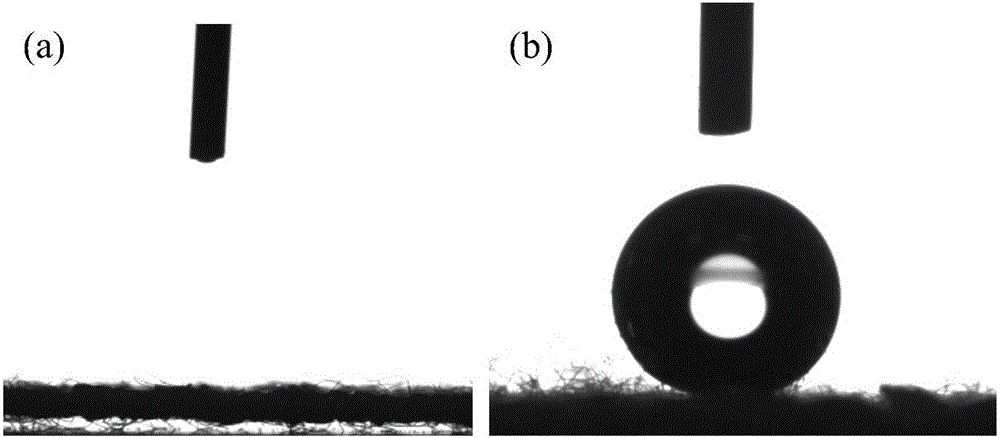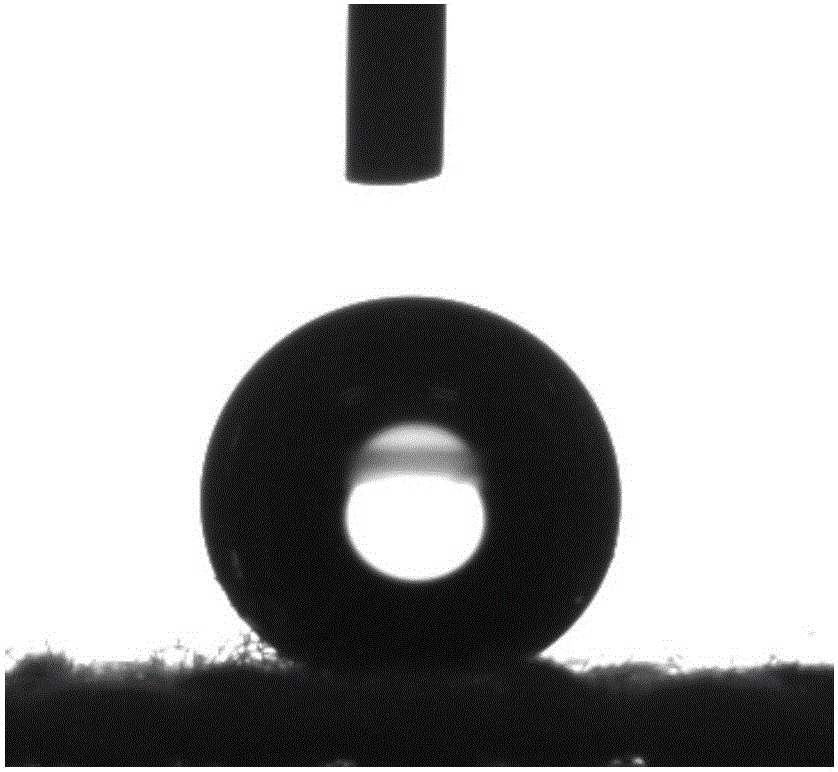Method for preparing super-hydrophobic textile from thiol-ene click chemistry-modified fiber
An olefin click, chemical modification technology, applied in the direction of wear-resistant fibers, textiles and papermaking, liquid-repellent fibers, etc., can solve the problems of poor durability, harsh equipment requirements, weak force, etc.
- Summary
- Abstract
- Description
- Claims
- Application Information
AI Technical Summary
Problems solved by technology
Method used
Image
Examples
Embodiment 1
[0032] Step 1: Alkali steaming polyester fabric: first, boil polyester fabric (25cm×35cm, 22±0.6g) in boiling water for 30min, then dry to remove impurities on the fiber surface; then, soak the washed fabric in a concentration of Take it out after 5 minutes in 340g / L sodium hydroxide solution, put it in the middle of double-layer polyethylene film, and bake it at 110°C for 3 minutes. Finally, take out the fabric, wash it fully, and dry it (25cm×35cm, 16±0.6g).
[0033] Step 2: Treat polyester fabric with mercaptosilane modified alkali: put the steamed polyester fabric into a dyeing cup containing 0.04mL 3-mercaptopropyltriethoxysilane, react at 70°C for 90min, take it out and place it at 80°C Bake for 1 hour.
[0034]Step 3: Polyester fabric modified by mercapto-olefin click chemistry hydrophobization: put the mercapto-modified polyester fabric into the The volume ratio of the amount of solid to the amount of solvent N,N-dimethylformamide is 3:100 in the Erlenmeyer flask. Af...
Embodiment 2
[0036] Step 1: Alkali steaming polyester fabric: first, boil polyester fabric (25cm×35cm, 22±0.6g) in boiling water for 30min, then dry to remove impurities on the fiber surface; then, soak the washed fabric in a concentration of Take it out after 5 minutes in 380g / L sodium hydroxide solution, put it in the middle of double-layer polyethylene film, and bake it at 110°C for 3 minutes. Finally, take out the fabric, wash it fully, and dry it at 80°C (25cm×35cm, 16±0.6g).
[0037] Step 2: Treat polyester fabric with mercaptosilane modified alkali: Put the steamed polyester fabric into a dyeing cup containing 0.1mL 3-mercaptopropyltriethoxysilane, react at 110°C for 90min, take it out and place it at 80°C Bake for 1 hour.
[0038] Step 3: Polyester fabric modified by mercapto-olefin click chemistry hydrophobization: put the mercapto-modified polyester fabric in the The volume ratio of the volume ratio of the amount of the body to the solvent N, N-dimethylformamide is 8:100. After...
Embodiment 3
[0040] Step 1: Alkali steaming polyester fabric: first, boil polyester fabric (25cm×35cm, 22±0.6g) in boiling water for 30min, then dry to remove impurities on the fiber surface; then, soak the washed fabric in a concentration of Take it out after 5 minutes in 400g / L sodium hydroxide solution, put it in the middle of double-layer polyethylene film, and bake it at 110°C for 3 minutes. Finally, take out the fabric, wash it fully, and dry it at 80°C (25cm×35cm, 16±0.6g).
[0041] Step 2: Treat polyester fabric with mercaptosilane modified alkali: Put the steamed polyester fabric into a dyeing cup containing 0.04-0.1mL 3-mercaptopropyltriethoxysilane, react at 90°C for 90min, take it out and put it in Bake at 80°C for 1 hour.
[0042] Step 3: Polyester fabric modified by mercapto-olefin click chemistry hydrophobization: put the mercapto-modified polyester fabric in the The volume ratio of the volume ratio of the amount of the body to the solvent N,N-dimethylformamide is 5:100. A...
PUM
 Login to View More
Login to View More Abstract
Description
Claims
Application Information
 Login to View More
Login to View More - R&D
- Intellectual Property
- Life Sciences
- Materials
- Tech Scout
- Unparalleled Data Quality
- Higher Quality Content
- 60% Fewer Hallucinations
Browse by: Latest US Patents, China's latest patents, Technical Efficacy Thesaurus, Application Domain, Technology Topic, Popular Technical Reports.
© 2025 PatSnap. All rights reserved.Legal|Privacy policy|Modern Slavery Act Transparency Statement|Sitemap|About US| Contact US: help@patsnap.com


